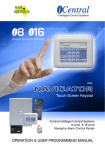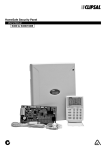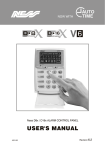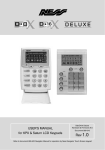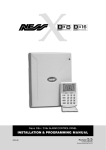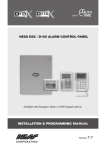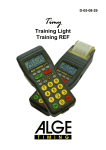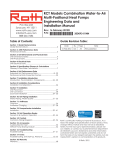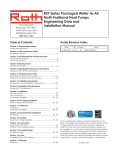Download USer`S ManUal
Transcript
Touch Screen Keypad User’s Manual D8x/D16x Navigator Alarm Control Panels V7 Operation and User Programming Manual Ness Corporation Pty Ltd ABN 28 069 984 372 Private Bag 23 Seven Hills NSW 1730 Australia Ph +61 2 8825 9222 Fax +61 2 9838 8508 Email: [email protected] SYDNEY Ph 02 8825 9222 Fax 02 9674 2520 [email protected] www.ness.com.au MELBOURNE Ph 03 9875 6400 Fax 03 9875 6422 [email protected] BRISBANE Ph 07 3399 4910 Fax 07 3217 9711 [email protected] “Australia’s largest designer and manufacturer of high quality security products” N55 PERTH Ph 08 9328 2511 Fax 08 9227 7073 [email protected] Adelaide Ph 08 8152 0000 Fax 08 8152 0100 [email protected] D8x/D16x Navigator USER Manual Rev 1, May 2010 Document Part Number: 890-402 WARNING ADSL NOTICE Installation and maintenance to be performed by qualified service personnel only. ADSL broadband data can interfere with the operation of your alarm dialler. CAUTION It is recommended that a quality ADSL filter be installed as per the filter manufacturer's guidelines in all premises with an alarm dialler installed. Risk of explosion if battery is replaced by an incorrect type. Dispose of used batteries according to the instructions on the battery. Copyright Notice All rights reserved. No part of this publication may be reproduced, transmitted or stored in a retrieval system in any form or by any means, electronic, mechanical, photocopying, recording, or otherwise, without the prior written permission of Ness. Ness reserves the right to make changes to features and specifications at any time without prior notification in the interest of ongoing product development and improvement. © 2010 Ness Security Products Pty Ltd ABN 28 069 984 372 Contents Introduction. . . . . . . . . . . . . . . . . . . . . . . . . . . . . . . . . . . . . . . . . . . . . . . . 4 Navigator System overview . . . . . . . . . . . . . . . . . . . . . . . . . . . . . . . . . . . 5 Navigator Touch Screen Keypad overview. . . . . . . . . . . . . . . . . . . . . . . . 6 Information Screen. . . . . . . . . . . . . . . . . . . . . . . . . . . . . . . . . . . . . . . . . . 7 Care & Cleaning. . . . . . . . . . . . . . . . . . . . . . . . . . . . . . . . . . . . . . . . . . . . 8 Applying the Protective Film. . . . . . . . . . . . . . . . . . . . . . . . . . . . . . . . . . . 9 Zone Status Display. . . . . . . . . . . . . . . . . . . . . . . . . . . . . . . . . . . . . . . . 10 Clock Display . . . . . . . . . . . . . . . . . . . . . . . . . . . . . . . . . . . . . . . . . . . . . 11 System Alarm Displays. . . . . . . . . . . . . . . . . . . . . . . . . . . . . . . . . . . 12, 13 Arming the System. . . . . . . . . . . . . . . . . . . . . . . . . . . . . . . . . . . . . . . . . 14 Disarming the System. . . . . . . . . . . . . . . . . . . . . . . . . . . . . . . . . . . . . . . 15 Home Mode . . . . . . . . . . . . . . . . . . . . . . . . . . . . . . . . . . . . . . . . . . . . . . 16 Duress Alarm. . . . . . . . . . . . . . . . . . . . . . . . . . . . . . . . . . . . . . . . . . . . . . 17 Emergency Alarms . . . . . . . . . . . . . . . . . . . . . . . . . . . . . . . . . . . . . . . . . 18 Excluding Zones. . . . . . . . . . . . . . . . . . . . . . . . . . . . . . . . . . . . . . . . . . . 19 Event Memory. . . . . . . . . . . . . . . . . . . . . . . . . . . . . . . . . . . . . . . . . . . . . 20 Day Mode Setup. . . . . . . . . . . . . . . . . . . . . . . . . . . . . . . . . . . . . . . . . . . 21 Day Mode Operation. . . . . . . . . . . . . . . . . . . . . . . . . . . . . . . . . . . . . . . . 22 Auto Time Automation . . . . . . . . . . . . . . . . . . . . . . . . . . . . . . . . . . . . . . 23 Auxiliary Outputs, Manual Operation. . . . . . . . . . . . . . . . . . . . . . . . . . . 24 Programming . . . . . . . . . . . . . . . . . . . . . . . . . . . . . . . . . . . . . . . . . . . . . 25 How to enter program mode. . . . . . . . . . . . . . . . . . . . . . . . . . . . . . . . 26 Set Brightness, Set Volume. . . . . . . . . . . . . . . . . . . . . . . . . . . . . . . . . 27 Edit Zone Names, Edit AUX Output Names . . . . . . . . . . . . . . . . . . . . 28 Zone Name Library . . . . . . . . . . . . . . . . . . . . . . . . . . . . . . . . . . . . . . . 29 Setting the Real Time Clock . . . . . . . . . . . . . . . . . . . . . . . . . . . . . . . . 30 User Codes Options Table. . . . . . . . . . . . . . . . . . . . . . . . . . . . . . . . . . 31 User Codes Programming. . . . . . . . . . . . . . . . . . . . . . . . . . . . . . . . . . 32 Radio Keys Programming. . . . . . . . . . . . . . . . . . . . . . . . . . . . . . . . . . 33 Timer Programming, Entry/Exit Delays. . . . . . . . . . . . . . . . . . . . . . . . 34 Follow Me Telephone Number Programming. . . . . . . . . . . . . . . . . . . 35 Monitoring Operation. . . . . . . . . . . . . . . . . . . . . . . . . . . . . . . . . . . . . . . 36 Remote Operation by Telephone. . . . . . . . . . . . . . . . . . . . . . . . . . . . . . 37 Troubleshooting . . . . . . . . . . . . . . . . . . . . . . . . . . . . . . . . . . . . . . . . . . . 38 Installation Record . . . . . . . . . . . . . . . . . . . . . . . . . . . . . . . . . . . . . . . . . 39 Introduction The Ness Navigator is a revolutionary touch screen interface for use with the Ness D8x/D16x1 series alarm control panels. Zone descriptions are displayed in plain English and you can even edit zone names yourself to reflect the names of rooms in your own premises. Navigator has a large touch sensitive 3.5” colour LCD which is easy to read, easy to use and makes operating your Ness alarm system a real pleasure. Not only does Navigator provide valuable information about your Ness alarm system, it allows you to arm and disarm your system, tells you what the system is doing, you can use it to program alarm system and if that’s not enough - Navigator just looks great! The large colour screen means Navigator can tell you much more than a conventional keypad can. 1 Navigator Touch Screen Keypad is compatible with Ness D8x and D16x control panels Version 7 and later. Your Navigator System Your Ness Alarm System Ness Navigator Touch Screen Keypad is the face of your Ness D8x or D16x Navigator Alarm System. Navigator’s self-explanatory operation guides provide you with plain English displays and intuitive touch screen operation. The interactive display screens make it easy to view all your zones with your own text descriptions, get help and prompts for arming, disarming, operating outputs, emergency alarms and more. Touch Screen Keypad Touch Screen Keypad Touch Screen Keypad Touch Screen Keypad Up to four Navigator Touch Screen Keypads per system. 8 or 16 Zones for PIRs, Door & Window Switches, Vibration Sensors, Smoke Detectors... OPTIONAL Card/Fob Reader OPTIONAL RADIO DEVICES Radio keys, PIRs, Radio Reed Switches, Radio Keypad, Radio Smoke Detector... Internal Siren MAIN HOUSING External Siren Strobe Light Auxiliary Outputs for optional connection to Electric Roller Doors, Lighting, Line Fail Output, Radio Key Panic Output, Radio Key AUX Output and more... RKP 17V AC Plug Pack (Supplied) R A D I O K E Y PA D Telephone Dialler Built-in Telephone Lead (Supplied) Overview The Disarmed Screen In the normal disarmed mode, the Navigator screen displays information about the state of your system and gives you instant access to commonly used functions. 6 7 1 8 2 9 3 10 4 11 5 1 Touch to arm the system. Page 14. 2 Touch to arm Home Mode. Page 16. 3 Touch to Exclude zones. Page 19. 4 Touch to view the event memory. Page 20. 5 Numeric keypad. 6 Touch to view the full zone list. Page 10. 7 Touch here to view the calendar. Page 11. This area also displays System Alarms. Page 12. 8 Touch to activate the Emergency Alarms. Page 18. 9 This area displays current Emergency Alarms. 10 Touch to control the Auxiliary Outputs. Page 24. 11 Touch to display the information screens. Page 7. Info Screen See page 8. Ness Corporation contact details. Your installer’s contact details are stored here. Never lose a business card again! Care & Cleaning Caring for your Navigator Do not use a pen, screwdriver or other sharp implement to press the touch screen. Permanent damage may result and will invalidate any warranties. Please press lightly, the touch screen does not need heavy force to operate. Pressing too hard may damage the LCD screen and the housing. Navigator responds to every touch with a short beep. Cleaning The Touch Screen Do not clean the touch screen with abrasive cleaners. Navigator’s Clean Screen page. While the system is disarmed, press Info, Clean Screen to see the cleaning instructions. Step 1. In the disarmed mode, press Info. Step 2. Press Clean Screen. Step 3. Press Start. Step 4. The touch screen will be disabled for 10 seconds. Clean the bare screen or the protective film using a soft dry cloth or a cloth moistened with Isopropyl Alcohol. Avoid chemical cleaners and solvents which may damage plastic components. You have 10 seconds left. Screen cleaning time has finished. Screen Protection Applying the Protective Film Navigator Touch Screen Keypad is supplied with two self-adhesive screen protectors. Please apply one protector and keep the other as a spare. The Protective Film is supplied to protect the sensitive touch surface from marks and scratches which may appear under normal use. We highly recommend you apply the film to keep your touch screen looking brand new for years to come. Step 1. Use the orange No. 1 tab to peel off the self-adhesive backing. Step 2. Flip the film over to position the green No. 2 tab at the top left. Please peel off this mask BEFORE application Step 3. Holding the protective film by the green tab, carefully apply the film to the Navigator’s screen. Start applying at one end and smooth the film as you go to remove any air bubbles Please peel off this mask AFTER application completed Please peel off this mask AFTER application completed Step 4. Use the green tab to peel off and discard the topmost layer of the film. Your Navigator is now ready for use. Zone Status Display Touch the Zone Status Bar to display the full zone list. The Zone Status Bar displays the zone numbers of unsealed zones. If only one zone is unsealed its description will also be displayed. Zones which are currently in the alarmed state are displayed in flashing red text. Touch to close the window. The zone number and description of all zones. Unsealed zones show a red indicator. The Zone List display will show 8 or 16 zones depending on whether your Navigator Control Panel is a D8x or D16x. Zone names can be customised in program mode. Page 28. 10 Clock Display The date and time are normally displayed when the system is armed or disarmed. The date and time can be set in User Program Mode, see page 30. If there is a System Alarm, this area will display the alarm. See next page. To display the full calendar. Touch Touch to close the window. 11 System Alarm Display If there is a System Alarm, the clock area will display the alarm. Touch to display details. To display System Alarm details. Touch Full description of the System Alarm and what action to take. Outstanding System Alarms shown here. Dialler Communication Fail means your dialler was not able to send an alarm message. This message is usually seen if the panel has not been acknowledged remotely if using Audible Monitoring. See page 36. Touch Next to view any other System Alarms. Touch to close the window. 12 the system alarm area. System Alarm Display Radio Key low battery alarm. Radio Tamper alarm indicates that a device such as a Radio Reed Switch or the R12 Radio PIR may have been opened. Check the device. Radio Supervision, if enabled by your installer, alerts you if a radio device has not transmitted a signal for a set interval. Ask your installer to check the radio device. External Tamper alarm and Panel Tamper alarms. Check the external siren cover and main panel. Touch to close the window. 13 To Arm The control panel must be armed in order to detect intruders. Before arming, make sure all zones are “sealed” by ensuring there is no movement in rooms covered by motion detectors and that doors or windows protected by reed switches are closed. The display will tell you when the system is ready for arming. Siren Warning At the end of the exit time, all zones should be sealed. If any are unsealed, the siren will sound for 2 seconds to indicate that those zones have been automatically excluded. You should disarm the panel, check the premises and then arm again. Continual warnings could mean there is a problem with a detection device - you will have to manually exclude the zone before attempting to arm the system. To arm the system. Touch or touch + + + A valid user code. If a zone is unsealed at the end of exit time and the auto-exclude option is disabled, the siren will sound for the duration of siren time, (the default is 5 minutes). 10 10 beeps on arming means mains power may be turned off or the backup battery is low. One long beep when you arm could mean the panel is already armed or the keypad code is wrong, (if not using Shortcut Arming). 14 To Disarm When you enter the protected premises through a delay zone, the keypad responds with regular beeps1 as a reminder to disarm. If the panel is not disarmed by the end of the entry delay time, an alarm will occur. Using the optional radio keys, you may disarm your system from inside your premises or from just outside.2 If you make a mistake when entering your user code, press”E” and start again. Five incorrect entries will cause an alarm. To disarm the system. Touch + A valid user code. The panel can be reset and the siren/s silenced by disarming the panel. If you arrive at your premises and find the strobe light flashing3 (if installed), reset the panel as above. To check the cause of the alarm, you can view the alarms in memory by entering Memory Mode. Arm Only codes User codes can optionally be programmed to be Arm Only codes. An Arm Only code can arm the system but it cannot disarm. However if an Arm Only code is assigned to a radio key, the radio key OFF button will arm and disarm. 1 Auto Re-Arm Your panel may be programmed for Auto ReArm to help prevent accidental disarming. Auto Re-Arm checks that you have entered the premises after disarming. If all zones remain sealed for a period as set by the entry delay time then the panel will re-arm. This is most useful when used with radio keys where the OFF button might be accidentally pressed after you have armed and are leaving the premises. If Entry Beeps are enabled. The strobe light will flash to indicate arming and disarming by radio key. Your installer can also enable siren ‘Chirps’ for an audible indication of radio key operation. 2 In the event of an alarm, the strobe light will flash for 72 hours or until the panel is reset. 3 15 To Arm Home Mode Home mode allows you to arm selected zones while others are ignored. Typically, perimeter zones (doors and windows) can be monitored while you are at home. Your installer must program which zones will be active in Home mode. Touch or touch + + + A valid user code. If an alarm occurs while in Home mode, entering a valid user code + E will silence the alarm. This will also disarm the panel, so remember to re-arm Home mode again if needed. Using the optional Radio Keys you can arm Home Mode by pressing either the OFF button or the ON button twice within 4 seconds or by pressing the AUX button, (RK4 radio key only). These options must be enabled by your installer. Note: Home Mode and Area arming Home Mode can be used if the panel is fully disarmed or if only Area2 is armed. Home Mode is not available when Area 1 is armed. Note The panel can be armed in Home mode if Area2 is already armed on these conditions: has enabled Home Mode. In normal disarmed mode, the Home Mode button • Area 1 must be OFF. • Area 2 must be armed first, and then Home Mode armed – not the reverse. • Zones assigned to both Home mode and to Area 2 will act as Home Mode zones when both Area 2 and Home Mode are armed. Note: Home Mode arming when Area2 is armed cannot be done by Radio Key or by keyswitch. 16 is visible only if your installer Keypad Duress Alarm The DURESS alarm can be used to send a silent alarm to the central station that you are being forced to disarm the panel against your will. That is - you are disarming under “duress.” To trigger the keypad Duress Alarm, add a special digit before your user code when disarming. Touch + + A valid user code. To disarm and send a DURESS alarm, prefix your User Code with one of the digits 5, 6, 8 or 9 when disarming. You can precede your user code with any of the digits 5, 6, 8 or 9. * The Keypad DURESS is normally not enabled. To enable this function, consult your installer. * DURESS alarms can only used by systems which are monitored by a Central Station. * The DURESS alarm can be programmed to sound the internal siren (Reset output). This option is Off by default. Your system will now be disarmed and a silent Duress alarm is sent to your central monitoring station. 17 Emergency Alarms Panic Alarm The Panic alarm may have been programmed to be either Audible to activate the sirens, or Silent to send a PANIC report by dialler if your system is monitored by a Central Station. To trigger Emergency alarms. Touch The Emergency Alarm display will show Medical and Fire alarms only if they have been enabled by your installer. The Medical alarm sends a medical alarm report by dialler if this option has been enabled by your installer and the system is monitored by a central station. The Medical Alarm does not sound the sirens. The Fire alarm sounds the siren using the Fire Alarm sound and sends a Fire Alarm report by dialler. If this option has been enabled by your installer and the system is monitored by a central station. If the Panic Alarm Shortcut is not enabled, you are required to enter your user code + E to trigger the panic alarm. Touch 18 to close the window. Excluding Zones If there is a problem with a detection device and the zone cannot be sealed when arming the panel, then that zone can be manually Excluded so that it does not generate alarms. To Exclude zones. Touch Then touch the zone name/s to toggle the exclude status for one or more zones. When zones have been Excluded, the EXCLUDE light flashes continuously while the panel is disarmed and also when armed. Excluded zones are indicated by the Zones can be excluded while the panel is either disarmed or armed. See notes below. Zone Exclude is not permanent. Excluded zones are automatically included next time the panel is disarmed. Touch Flashing In both disarmed and armed modes, the Zones Excluded icon flashes to indicate that there are zone/s excluded. Flashing 19 to close the window. icon. Event Memory The panel stores a comprehensive event memory, including Arming, Disarming, Low Battery, Mains Fail and Alarm events. To view the Event memory. Touch The memory is constantly upgraded and the last 30 events are always available for viewing. This memory display can only be selected while the panel is in the disarmed state. The MEMORY button flashes continuously when an alarm has occurred as a reminder to view the alarm memory. Touching the MEMORY button to view the event history also clears the flashing memory alert. Press Next to view the event memory from most recent to oldest. The Event Memory window will close automatically when the last event has been viewed. Touch to close the window. There is no need to refer to charts or tables - the event memory describes exactly what you’re viewing, in plain English. 20 Day Mode - Set up Your Navigator control panel has a Temporary Day Zone feature which allows easy and flexible Day Zone selection and operation. Temporary Day Zones operate in addition to Permanent Day Zones which are usually set up by your installer. You can easily enable and disable Temporary Day Zones and even program which zones will be Day Zones from the Navigator Touch Screen keypad. Select which zones will be Temporary Day Zones. You probably will only need to do this once or occasionally. To enter Temporary Day Zones selection. Touch Then touch the zone name/s you want to enable or disable as Day Zones. Selected zones are indicated by the Day Zones can be programmed by your installer to beep the keypad, or briefly sound the siren/s or flash the strobe light, or to sound an optional buzzer. Typical Applications Day Zones are useful for a variety of applications such as a shop door beeper triggered by a reed switch on the door. For example, in a shop situation you can use Day Mode to alert you when a customer enters the front door. You can also use Temporary Day Zones to monitor switches on, for example, the rear door or the fridge doors. Note for installers and advanced users: Permanent Day Zones are not displayed in selection mode. Permanent Day Zones can be selected as Temporary Day Zones but this has no effect as those zones are already day zones. Touch + to close the window. 21 icon. Day Mode - Operation This enables/disables both Temporary and Permanent Day Zones. When Day Mode is enabled, any unsealed day zone will sound the programmed output for 2 seconds. When Day Mode is disabled, an unsealed day zone will simply be indicated on the keypad as an unsealed zone. Day Mode can be enabled when the panel is in the normal disarmed mode. To enable Day Mode. Touch + To disable Day Mode. Touch 22 + Auto Time Auto Time - automating your Navigator security system. Your D8x/D16x Navigator panel features sophisticated automation features making full use of the onboard Real Time Clock and a set of powerful yet simple to program options. ARMED ARMED HOME Arm or Disarm automatically at pre-programmed times of day or day of the week. Increase site security. No need to rely on staff remembering to arm or disarm the system. Turn AUX outputs on or off at pre-programmed times - every day, once a week, any time. Automate doors, sprinkler systems, lights and more. Enable/disable user codes depending on the time of day or day of the week. Allows managers to grant users access to the system at selected times and deny after hours entry. Auto Time Warning Period (Optional function - must be enabled by your installer.) When an Auto Time event is about to begin, your keypad (or keypads) will begin a constant slow beep as a warning that the automatic event is about to happen. The warning beeps can be programmed to start up to 99 minutes prior to the AutoTime event. Press any key on the keypad to stop the beeps during the warning period. The beeps will start again for the final minute at a faster rate. Final Minute beeps. In the last minute prior to the Auto Time event, the keypad will beep at a faster rate to warn that the event is about to start. To Delay The Auto Time Event (Optional function - must be enabled by your installer.) To delay the Auto Time event, enter a valid user code on its own. (The user code must be assigned to an Area to work). This will suspend the warning beeps and the AutoTime event for 1 hour - when the warning process will start again. Example: Your panel is programmed to Auto Arm at 6pm every weekday and the Warning Period is programmed for 5 minutes. You are working back late and at 5:55pm your keypad begins to beep. Since you're not ready to arm the system yet, enter your user code (without pressing E) at the keypad. The warning beeps will stop and arming will be delayed by one hour. At 6:55pm the warning beeps will start again, followed by automatic arming if you don't delay the event again. Any AutoTime event can be postponed, not just arming. You can also delay the automatic turn (or off) of one of the AUX outputs in the same manner. 23 AUX Outputs - Manual Operation Manual Operation Of the Aux Outputs (Optional function - must be enabled by your installer.) As well as automatic operation by Auto Time, the four auxiliary outputs can also be operated manually by keypad. To operate the AUX outputs. Touch Auxiliary Control is available in all modes, including when the system is armed. The Auxiliary Output Control screen shows the AUX outputs which have been programmed for keypad control by your installer. Touch a button to Pulse on or toggle an output. (Pulse or toggle is programmed by your installer.) Manual Operation and Auto Time Schedules Manual operation of outputs works in conjunction with AutoTime schedules, if programmed. For example, if AutoTime has turned an output on as scheduled (say, a light) you can manually turn it off (and back on again) any time you wish. At the scheduled turn OFF time, if the output is still on it will be turned off. 24 Programming How to enter program mode . . . . . . . . . . . . . . . . . . . . . . . . . . . . . . . . . 26 Set Brightness, Set Volume . . . . . . . . . . . . . . . . . . . . . . . . . . . . . . . . . . 27 Edit Zone Names, Edit AUX Output Names. . . . . . . . . . . . . . . . . . . . . . 28 Zone Name Library. . . . . . . . . . . . . . . . . . . . . . . . . . . . . . . . . . . . . . . . . 29 Setting the Real Time Clock. . . . . . . . . . . . . . . . . . . . . . . . . . . . . . . . . . 30 User Codes Options Table. . . . . . . . . . . . . . . . . . . . . . . . . . . . . . . . . . . 31 User Codes Programming . . . . . . . . . . . . . . . . . . . . . . . . . . . . . . . . . . . 32 Radio Keys Programming. . . . . . . . . . . . . . . . . . . . . . . . . . . . . . . . . . . . 33 Timer Programming, Entry/Exit Delays . . . . . . . . . . . . . . . . . . . . . . . . . 34 Follow Me Telephone Number Programming . . . . . . . . . . . . . . . . . . . . 35 25 Programming - How to enter Program Mode In User Program Mode you can program User Codes, Timers, Real Time Clock, Follow Me Telephone Number. User Codes Enter program mode when the panel is in the normal disarmed mode. To enter User Program Mode. Touch + The panel has 56 user codes which can be operated by keypad code (3-6 digit PIN), by optional radio key or by optional access cards. + Your Master code. The factory default Master Code is 123. You should re-program this code with a new code of your own choice. Timers You can also re-program the Entry Delay Time and Exit Delay Time if you need more or less time to exit and enter the premises. Real Time Clock Some automation features such as AutoTime rely on the onboard Real Time Clock. Set the current date and time to ensure events take place as expected. You will need to adjust the Hours setting when Daylight Savings starts and ends. To exit User Program Mode. Touch + The panel will automatically exit Program Mode if the keypad is inactive for 4 minutes. Follow Me Telephone Number If your panel is set up for Audible Voice monitoring, you can program the Follow Me Telephone Number to temporarily replace the two installer-programmed phone numbers. 26 Programming - Navigator Configuration The Navigator Configuration screen allows you to: Set Brightness In User Program Mode. Touch Adjust the brightness of the Navigator’s LCD screen backlighting to suit the room. Set Volume Adjust the beep volume of the Navigator touch screen. Default All Config Items This option deletes your custom settings and returns all configuration options to factory default settings. Slide your finger along the Brightness slider to adjust the brightness from 1% to 100% Slide your finger along the Volume slider to adjust the touch screen beep volume from 1% to 100%. The volume cannot be set to zero. 27 Programming - Navigator Configuration Edit Zone Names Edit the zone names to suit your own premises. For example, instead than meaningless numbers, zones can be given names that mean something to you, such as Front Door, Back Door, Lounge Room, etc. You can choose from a library of common zone names or type your own names using the on screen QWERTY keyboard. Edit Aux Output Names If your installer has installed automation options, you can edit the names of the four auxiliary outputs. The example opposite shows how to edit Zone Names. Follow the same procedure to edit Aux Output Names. Touch a zone name. If you have a Navigator D8x panel this display will show 8 zones. Next/Previous zone Backspace Move cursor Left/Right Opens zone name library To return to the zone list Edit the name of the zone. 28 Programming - Navigator Configuration Editing Zone Names Using the Zone Name Library. Touch a zone name to display the zone name editor. Next/Previous zone Backspace Move cursor Left/Right Opens zone name library To return to the zone list Touch Select to open the zone name library. The Zone Name Library. You can use the zone name editor to type the names of all your zones. To save you time, Navigator Touch keypad has a built-in library of common zone names. You can even choose a zone name from the library and add more text to customise it further. For example. Choose “Garage” from the library and add “Roller Door” or “Detector” or “Window”. Choose a pre-defined zone name from the library then press to close the library. 29 Programming the Real Time Clock This option allows you to program: In User Program Mode. Day Of Month (01-31) Month (01-12) Touch Year (10-63) Hour (00-23) 24hr time format Minute (00-59) The Day Of Week does not need to be programmed. It is automatically calculated from the date. To program. Touch + 01-31 + Touch + 01-12 + Touch + 10-63 + Touch + 00-23 + Touch + 00-59 + EXAMPLE: To set the Day Of Month. Touch Enter Day of Month (01-31) + The green status bar will show the new setting. 30 Programming User Codes User Code programming rules • User Code 1 is also the Master Code which is used to enter User Program mode. • Up to 56 Keypad Codes can be used at up to 4 wired Navigator keypads for controlling all panel functions including Arming & Disarming, Home Mode, Panic, memory recall and much more. • User Codes 2 to 56 can be programmed to be Radio Codes or Access Cards as required. Ask your installer. • Keypad Codes (or PINs) can be 3 to 6 digits in length and can be individually programmed and deleted. User Code 1 (Master Code) Option no. PIN P201E 123 User Code Option no. 29 P229E 2 P202E 30 P230E 3 P203E 31 P231E 4 P204E 32 P232E 5 P205E 33 P233E 6 P206E 34 P234E 7 P207E 35 P235E 8 P208E 36 P236E 9 P209E 37 P237E 10 P210E 38 P238E 11 P211E 39 P239E 12 P212E 40 P240E 13 P213E 41 P241E 14 P214E 42 P242E 15 P215E 43 P243E 16 P216E 44 P244E 17 P217E 45 P245E 18 P218E 46 P246E 19 P219E 47 P247E 20 P220E 48 P248E 21 P221E 49 P249E 22 P222E 50 P250E 23 P223E 51 P251E 24 P224E 52 P252E 25 P225E 53 P253E 26 P226E 54 P254E 27 P227E 55 P255E 28 P228E 56 P256E 31 PIN Programming User Codes In User Program Mode. Refer to the User Code options table on page 31 then enter the option number of the user code you want to program. Touch + + 3 digit option number The option number and the current user code is displayed. Now enter your new user code (PIN). The code can be 3 to 6 digits in length. Note 1. User codes must NOT start with zero. (The panel will allow codes beginning with zero to be programmed but they will not operate the panel. This is an alternative method for disabling user codes.) Touch Your new PIN + Then enter the PIN again to confirm. Touch Your new PIN + Note 2. All codes must be unique to each other. Codes are rejected if already used. Some codes that are similar to existing codes may also be rejected. Touch to delete a user code. The new user code will be displayed. Arm Only Codes If a code has been programmed by your installer to be an Arm Only code, then that user code can arm but not disarm the panel. This is handy for cleaners, temporary staff etc. 32 Programming Radio Keys Each of the User Codes, except for the Master Code, can be programmed to be Radio Codes. This allows up to 55 Ness Radio Keys to be used for arming and disarming of the panel. The optional Ness Radio Interface is required for radio operation. Ask your installer. In User Program Mode. Refer to the User Code options table on page 31 then enter the option number of the user code you want to program. Touch + + 3 digit option number Example, P203E Indicates that this code has been enabled as a Radio Code. If the option has been enabled by your installer. Touch to delete a Radio Key. Touch The display will show Press the disarm button on your Ness Radio Key (or the No. 1 button). The green status bar will indicate that the Radio Key was successfully programmed. If you hear a long beep, the Radio key may already be programmed at another user code. 33 Programming Timers This option allows you to program: Entry Delay Time 1 (01-99 sec) Entry Delay Time 1 sets the time allowed to enter the premises through a delay zone. In User Program Mode. Touch Entry Delay Time 2 (01-990 sec) If enabled by your installer, this timer is used to give extra long entry delay on selected zones. Entry Delay Time 2 is internally multiplied by 10. For example, enter 12 to get a time of 120 seconds. Exit Delay Time (01-99 sec) Exit Delay Time sets the time allowed to exit the premises after arming. All zones, except 24hr zones, are inactive during the Exit Delay Time. To program. Touch + 01-99 + Touch + 01-99 + Touch + 01-99 + EXAMPLE: To set Entry Delay Time 1. Touch The option number and the current delay time is displayed. Enter the new delay (01-99) The new delay time is displayed. 34 + Programming - Follow Me Telephone Number This option allows you to program: In User Program Mode. Follow Me Telephone Number Touch If your panel is set up for Audible Voice monitoring, you can program the Follow Me Telephone Number to temporarily replace the two installer-programmed phone numbers. If the Follow Me Telephone Number is blank the panel will report alarms to the Primary and Secondary phone numbers if they have been programmed by your installer. Use the Pause, star or hash keys to enter special characters if required. For example, if your phone system requires you to dial zero to pick up the line, press 0 followed by the Pause button then enter the phone number you want the panel to dial in the event of an alarm. To program. Touch The option number and the current phone number is displayed. 35 Enter the phone number + Monitoring Central Station Monitoring mains failure reports, and it can also (by user number) identify the users who arm and disarm the system. Ness Navigator control panels have a digital dialler which can send detailed alarm messages to a Central Monitoring Station. Central station monitoring is highly recommended and is the most effective method of monitoring your alarm system. The digital messages can include information about the zone or zones which caused the alarm, tamper alarms, low battery or For further information about 24 hour monitoring, contact your installer or Ness Corporation. If a Follow Me Telephone Number is programmed, the Primary and Secondary telephone numbers will be ignored. All alarm calls will be sent to the Follow Me Telephone Number. If your panel is monitored by a Central Station, the Follow Me number is ignored. Audible Monitoring Acknowledging the alarm As a lower security alternative to central station monitoring, the panel can be programmed to send audible messages to a fixed or mobile phone. edge the alarm by pressing the their telephone. The person receiving the call can acknowl- Press the message. When programmed for audible monitoring, the panel calls a pre-programmed number (or numbers) and sounds an audible alarm message and a series of beeps over the phone. These beeps can identify the zone or zones which caused the alarm as well as several other alarm types. key on key during gaps in the alarm Once you successfully acknowledge the alarm the panel will hang up and not ring any other telephone numbers until the next alarm. If you do not acknowledge the alarm the panel will ring you again and then it will ring the next programmed telephone number, (if any). The Audible Message When triggered by an alarm, the panel will dial the programmed telephone number/s and output the audible message "ALARM, ALARM, ALARM" and beeps for 45 seconds or until it is acknowledged. Note: If the alarm is not acknowledged, the LINE light on the Navigator keypad will display a Dialler Communications Fault until the panel is next armed. The "Follow Me" telephone number If your panel is programmed for Audible Monitoring, it will make alarm calls to the Primary and Secondary telephone numbers programmed by your installer. 36 Telephone Remote Operation Arm /Disarm and Operate AUX outputs by phone Ness Navigator control panels allow a user to call in to the panel, using a standard DTMF telephone, and remotely arm or disarm all areas and also turn on or off the Auxiliary outputs. To maintain panel security, remote operations can only be activated after entering a valid user code. To operate the panel by telephone, you need a DTMF capable telephone, a valid user code and you must know the telephone number of the line to which the panel is connected. Notes • If the panel does not receive commands for periods longer than 10 seconds it will assume that the call is finished and it will hang up. • If an alarm occurs which requires the panel to dial out while attempting remote control, the panel will treat the alarm as a priority, give a constant tone as a warning and then hang up. Sequence of Operation. 1. Phone the panel telephone number and listen for the required number of rings and then hang up. 2. Wait 10 seconds and then call the number again within 50 seconds. 3. The panel will answer the second call immediately, sound a beep for 2 seconds then, after a pause, it will sound a lower frequency tone. The panel is now ready to receive telephone commands. 4. Press the button on the telephone. This tells the panel that telephone commands will follow. The panel will respond with either 3 beeps if all OK (One long beep means try again). 5. Now enter a valid User Code (that is normally used for arming or disarming the panel) followed by the button. The panel will respond with 3 beeps if it recognises the code or 1 long beep to signal the code was invalid and to try again. 6.Enter the required command. See the summary of telephone commands below. 7. Press to finish. This tells the panel to hang up. Also hang up your telephone. telephone commands Prepare to receive commands Audible Feedback Arm Areas 3 beeps • The User Code is valid • Successful arm or disarm • An AUX output has been turned ON. Disarm Areas 1 long beep • Panel is already armed • Invalid code. Try again. • Remote AUX operation is not enabled Turn OFF AUX2 Turn ON or Pulse AUX1 Turn OFF AUX1 Turn ON or Pulse AUX2 Turn ON or Pulse AUX3 Turn OFF AUX3 Turn ON or Pulse AUX4 Turn OFF AUX4 1 Short beep • An AUX output has been turned OFF. Finished – hang up 37 Troubleshooting SYMPTOM POSSIBLE CAUSE REMEDY When arming, a zone light is on or the keypad gives a long beep. One or more detection device (a PIR or reed switch) may be unsealed. Find the cause of movement or close the door or window. • 10 beeps from keypad. • MAINS light is flashing. • BATTERY light is flashing. The mains power may be off, ...or the panel’s backup battery may be low, ...or a Radio Device battery may be low. Make sure the plug pack is plugged in and the power point is turned on. The backup battery may need replacing, call your installer. 1 long beep from the keypad. Invalid keypad entry. Press the E button and try again. 2 second siren at the end of Exit Delay time. A zone was unsealed at the end of exit delay time. Disarm the panel and check all zones. The strobe light is flashing. There has been an alarm within the last 72 hours. Reset the alarm by disarming the panel and check the Alarm Memory Siren sounds while the panel is disarmed. A 24 hour zone has been alarmed. (Siren Tamper, Box Tamper, Panic Button). Reset the alarm by disarming the panel and call your installer. EXCLUDE is flashing. A zone/s has been Excluded. This is to indicate that one or more zones have been Excluded. Cannot arm and EXCLUDE is displayed. You are in Exclude mode. Press E to exit Exclude mode. System Alarm TAMPER ALARM is flashing The 24 hour Tamper input has alarmed. (Siren tamper or box tamper). Call your installer. MEMORY is flashing. There are alarms in memory. To clear the ALARM MEMORY, view the Alarm memory otherwise the light will clear next time you arm the panel. Cannot enter Program Mode. The panel is armed. Disarm the panel before attempting to enter Program Mode. Or you may be attempting to enter program mode using one of the user codes. Try again using the Master Code. When I arm by radio key, ARMED on the keypad does not turn on immediately. The panel is waiting 5 seconds for a second press of the ON button to enter Home mode. This is normal operation when arming of Home mode by radio key is enabled. The keypad is making a continuous slow beep. This is the AutoTime warning beep which can be programmed to start from 1 to 99 minutes before an AutoTime event is due to begin. The beeps will continue during the AutoTime warning period changing to faster beep in the final minute prior to the AutoTime event. The panel re-arms itself a short time after disarming. Auto Re-Arm is enabled. Enter the premises after disarming. Auto Re-Arm is designed to re-arm the panel if you don't enter the premises after disarming. 38 DATE PURCHASED: INSTALLATION RECORD DATE INSTALLED: INSTALLATION COMPANY: TELEPHONE: MONITORING COMPANY: NESS D8 ALARM CONTROL PANEL P74E Report (dialler) Entrance, bedroom1, etc P57E SIREN OUTPUT DESCRIPTION P55E STROBE OUTPUT PIR, Reed switch, etc P54E RESET OUTPUT DEVICE TYPE P52E 24 HOUR ZONES P46E AREA 2 Minutes P51E MONITOR Seconds P29E SIREN RESET TIME P45E AREA 1 Seconds P28E EXIT DELAY TIME P40E INSTANT Seconds P27E ENTRY DELAY TIME 2 P42E HANDOVER P26E ENTRY DELAY TIME 1 P43E ENTRY DELAY 2 User programming options P41E ENTRY DELAY 1 ZONE ASSIGNMENT Installer programming options TIMERS P56E SONALERT OUTPUT TELEPHONE: NESS D16 ALARM CONTROL PANEL 1 2 D8 & D16 3 4 5 6 7 8 9 10 11 D16 12 13 14 15 16 USER CODE 1 Master Code Extra Options Assigned OPTION No E.g. Radio Code, Arm Only, etc. P201E USER CODE Extra Options Assigned OPTION No E.g. Radio Code, Arm Only, etc. USER CODE Extra Options Assigned OPTION No E.g. Radio Code, Arm Only, etc. 20 P220E 39 P239E 2 P202E 21 P221E 40 P240E 3 P203E 22 P222E 41 P241E 4 P204E 23 P223E 42 P242E 5 P205E 24 P224E 43 P243E 6 P206E 25 P225E 44 P244E 7 P207E 26 P226E 45 P245E 8 P208E 27 P227E 46 P246E 9 P209E 28 P228E 47 P247E 10 P210E 29 P229E 48 P248E 11 P211E 30 P230E 49 P249E 12 P212E 31 P231E 50 P250E 13 P213E 32 P232E 51 P251E 14 P214E 33 P233E 52 P252E 15 P215E 34 P234E 53 P253E 16 P216E 35 P235E 54 P254E 17 P217E 36 P236E 55 P255E 18 P218E 37 P237E 56 P256E 19 P219E 38 P238E © 2004 Ness Security Products 39









































